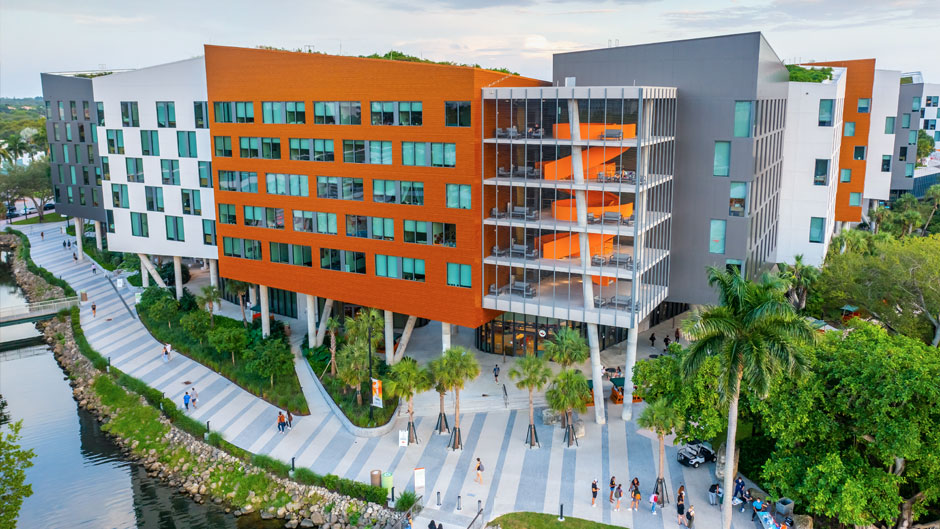Two years after its grand opening, the University of Miami’s Lakeside Village has been awarded one of the most prestigious green building ratings—a LEED Gold Certification by the U.S. Green Building Council.
LEED certification is an assessment and ranking of the facility’s energy consumption, its performance, and its design to minimize environmental impact, explained Jessica Brumley, vice president for facilities operations and planning. LEED certifications range from bronze to platinum.
“It’s important to us that as we’re providing state-of-the-art amenities, that we’re doing it in a responsible manner for the environment,” said Brumley. “I think our culture as an institution is very aggressive when it comes to sustainability.”
Lakeside Village’s award-winning architecture skillfully crafted by Arquitectonica includes innovative features and solutions to sea level rise and climate change. Its sloped rooftop green spaces help to slow water runoff, provide food for pollinator species of animals, and naturally insulate the buildings within the village. Additionally, it has innovative heating and cooling systems that condition and filter the air as well as reuse it for sustainable initiatives that support the campus community and beyond. Throughout the housing complex, state-of-the art occupancy sensors and smart thermostats were placed in each suite, providing about 28.5 percent in energy savings, compared to similar buildings.
Perhaps the most visible feature, Lakeside Village is built on stilts. This allows for increased walkability and airflow at the ground level, but “more importantly, it takes a visible stance on our standpoint for resilience and sea level rise and climate threats,” Brumley said.
The project also focused on fostering native ecosystems and plant species that are drought resistant while also attracting biodiversity. This will help to encourage a significant resurgence of butterflies in the area. The village also includes a rain garden.
Jon Baldessari, executive director of housing operations and facilities, helped to ensure that resident-students’ needs and expectations were considered throughout the design and construction phases. Baldessari was thrilled to learn of Lakeside Village’s gold certification.
“The efforts around LEED certification demonstrated the University’s commitment to environmental stewardship and social values through our efforts in planning, constructing, and maintaining our residential areas like Lakeside Village,” he said.
The 12-acre housing project is comprised of 25 interconnected buildings that are uniquely snaked around courtyards, outdoor terraces, retail, and study spaces, and provides five floors of modern residential living for students—primarily sophomores, juniors, and seniors. The development also includes a large exhibition space, an auditorium, a classroom, and a multiuse pavilion.
According to Brumley, Lakeside Village is one of the largest projects that the University has ever built and is a “huge achievement” for all involved because of its complexity, and it “sets the bar” for future buildings to come on the Coral Gables Campus.
As the institution grows, local and campus community members can expect more LEED buildings and renovations. Since 2007, the University has actively worked toward carbon neutrality and reducing its greenhouse gas emissions, and it now has more than 17 buildings across three campuses recognized as LEED certified—many of them reaching silver standard and above.
“The Knight Recital Hall under construction for the Frost School of Music and the Institute for Chemistry and Molecular Science that’s being constructed by the Ashe Building are both on track for similar LEED certifications,” Brumley noted.
Centennial Village, which breaks ground in May, will be the second phase of the University’s multiyear plan to modernize campus housing, and it also aims to achieve LEED certification.

